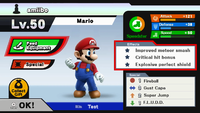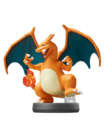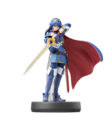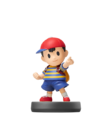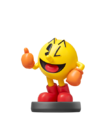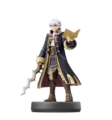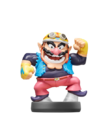amiibo
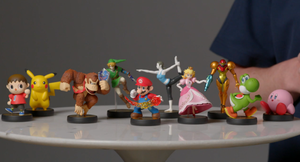
amiibo are a line of interactive figurines available for usage with the Wii U and Nintendo 3DS systems. By scanning an amiibo with near field communication technology, players can receive various effects in games. For the Wii U, amiibo are scanned using the Wii U GamePad. The New Nintendo 3DS models are also natively compatible with amiibo, while older 3DS models will require an adapter to use the figurines.[1] While the concept of figurines using NFC technology to interact with the Wii U was previously explored with Pokémon Rumble U, Super Smash Bros. 4 was the first game to feature the amiibo branding, acting as the debut and flagship title for the line.
In Super Smash Bros. 4
Super Smash Bros. 4 supports the use of amiibo, with its series of figurines representing the various characters available for play in the games. While all playable characters are represented, alternate costumes, such as Alph for Olimar, are not featured in the line. amiibo figurines are not required to unlock any characters or other features in the games, and they are completely optional for playing both versions.[2]
amiibo, when scanned by the console, allows the character represented by the figurines to be used in-game; the character can be modified by players with character customization options available in the game, and their stats can be modified further by "feeding" equipment to them. Unlike with normal fighters, amiibo fighters can be given any kind of equipment, including the ones that they're not normally compatible with; for example, an amiibo Mario can be given Hammer equipment, which would normally be impossible. There is a limit to how many times the amiibo can be fed in one session, however. amiibo also gain gold and other items while fighting which are retrieved when checking them in the amiibo menu. The longer the amiibo has fought the more presents and gold are received. Any trophies and CDs picked up by the amiibo can also be retrieved.
After this, they can be used as a specialized computer player, with the tag "FP" above them. If they are used as CPU fighters, figurines start at level 1 like regular CPU players, but as they fight more often, they can continue to level up, to a cap of 50. As they gain levels, amiibo can potentially "learn" techniques from other characters; if a player frequently uses long-ranged, camping techniques, then the amiibo will also begin to emulate this behavior. This learning continues even after the 50 level cap is reached. In addition, amiibo can gain improved fighting statistics, such as improved damage, knockback, and reaction times, the higher its level is. Finally, higher-levelled amiibo can adapt to individual matches faster than lower-leveled amiibo; if an opponent takes on an aggressive, rush-down style against an amiibo in one match, for instance, it will begin to make more use of defensive techniques like spot dodges and rolls.
amiibo can be used on any copy of the game, and the character on the amiibo is tied to the figurine, allowing for players to use its customized moveset and fighting style wherever they desire.
While Super Smash Bros. for Wii U natively supports amiibo, Super Smash Bros. for Nintendo 3DS currently does not do so, though Nintendo has confirmed a patch will eventually be released as to allow for such compatibility, provided the user also has the appropriate hardware, as noted above. This patch is set for a February 2015 release.
Release
For Smash, amiibo are being released in waves. Several staggered release dates have been announced, with each date containing a subset of the entire Smash lineup. The known waves, the figurines they contain, and their release dates are detailed below.
Smash-related amiibo are priced at $12.99 USD in the Americas, £10.99 GBP in the United Kingdom, ¥1200 JPY in Japan, and €14.99 EUR in the European Union.
Wave 1
The first wave of amiibo launched on November 21, 2014, alongside the North American release of Super Smash Bros. for Wii U.
- Donkey Kong amiibo.jpg
- Fox amiibo.jpg
- Kirby amiibo.jpg
- Link amiibo.jpg
- Mario amiibo.jpg
- Marth amiibo.jpg
- Peach amiibo.jpg
- Pikachu amiibo.jpg
- Samus amiibo.jpg
- Villager amiibo.jpg
- Wii Fit Trainer amiibo.jpg
- Yoshi amiibo.jpg
Wave 2
The second wave of amiibo was released on December 14, 2014 in North America and on December 19 in Europe.
- Captain Falcon amiibo.jpeg
- Diddy Kong amiibo.jpg
- Little Mac amiibo.jpg
- Luigi amiibo.jpg
- Pit amiibo.jpg
- Zelda amiibo.jpg
Wave 3
The third wave of amiibo will be released in Japan on January 22, 2015, in Australia on January 29, 2015, and in North America on February 6, 2015. In North America, several of the amiibo will be exclusively available through specific stores. In Europe, Bowser, Ike, Lucario, Rosalina & Luma, Sheik, and Toon Link will be released on January 23, 2015, and King Dedede, Mega Man, Meta Knight, Shulk, and Sonic on February 20, 2015.
- Bowser amiibo.jpg
- Ike amiibo.jpg
- King Dedede amiibo.jpg
- Lucario amiibo.jpg
Lucario (Toys "R" Us exclusive)
- Mega Man amiibo.jpg
- Meta Knight amiibo.jpg
Meta Knight (Best Buy exclusive)
- Rosalina & Luma amiibo.jpg
Rosalina & Luma (Target exclusive)
- Sheik amiibo.jpg
- Sonic amiibo.jpg
- Toon Link amiibo.jpg
Wave 4
The fourth wave of amiibo will be released in spring 2015.
Future releases
Shinya Takahashi of Nintendo's SPD division confirmed that the plan is to ultimately release amiibo figurines for all characters on the roster.[3] The original announcement of amiibo also featured a number of characters and designs for characters that do not have any amiibo planned or known, including ones for Lucina disguised as Marth, Mr. Game & Watch, an 8-bit Mario, Wario, and more.
Sales
Over 710,000 amiibo from Wave 1 were sold prior to the introduction of Wave 2, with Nintendo also stating that sales were approximately equal to those of Super Smash Bros. for Wii U.[4] amiibo of Link were said to be the most popular, with Mario and Pikachu being the second and third most popular, respectively. Pre-orders for amiibo of Rosalina & Luma also broke sales records for Target, with the figurines selling out in only 35 minutes.[5]
Gallery
Trivia
- A level 50 Fox amiibo called "WaveShine" was entered into a small, local tournament in Canada as a joke; initially losing its first match, the amiibo ended up making it to the loser's semifinals before finally being knocked out by semi-professional Brawl smasher FireFly.
- Various amiibo with production defects have been discovered, with the first of these attaining notoriety being an amiibo of Samus with two arm cannons instead of just one on her right arm; it later sold for $2500 USD on eBay. Following its discovery, several reports of other defective amiibo also surfaced, with some of them also being sold on eBay.
